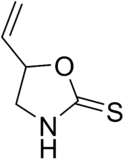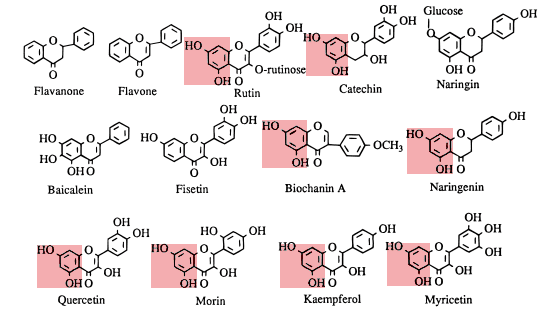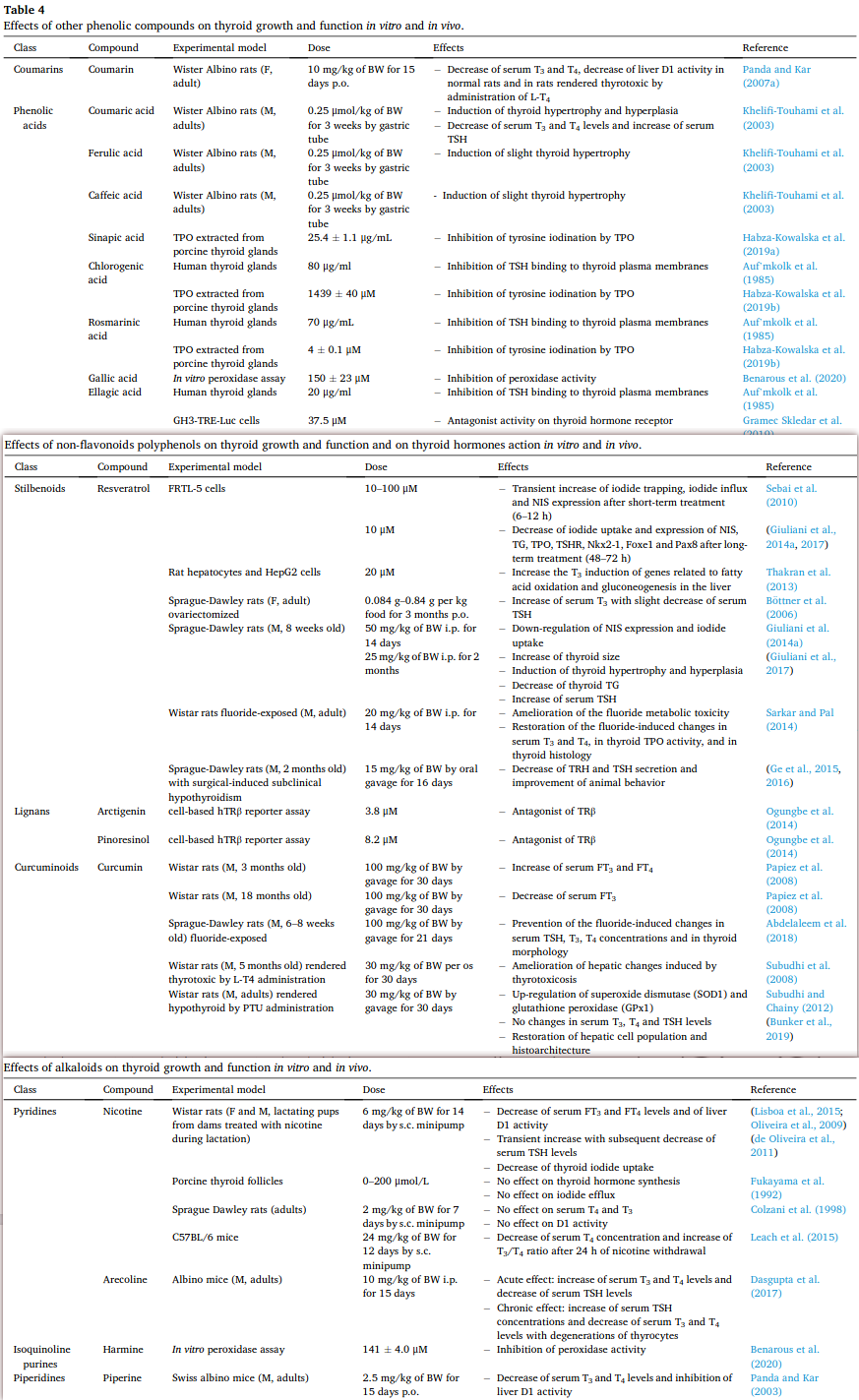Goitrin
2022-08-24: reference:
Goitrin
 #
#
- Progoitrin, a thioglycoside, converts into goitrin via intestinal microorganisms.
Gaitan E./ RPF #
-
Sulfurated organics
- Thiocyanates ($\ce{R-S-C#N}$) and isothiocyanates have been demonstrated as goitrogenic principles in plants of the Cruciferae family.
- Thiocyanate crosses the human placenta and may cause both goitre and neonatal hypothyroidism
- Thiocyanate or thiocyanate-like compounds Primarily inhibit the iodine-concentrating mechanism of the thyroid, and their goitrogenic activity can be overcome by iodine administration
- [Thiocyanate: a review and evaluation of the kinetics and the modes of action for thyroid hormone perturbations]
- Hydrophillic. Inhibits thyroidal uptake of Iodide via the sodium iodide symporter (NIS).
- Inhibits Iodine binding in the thyroid. Reversible and obviated by additional iodine ingestion. Brassica is very high, especially B. Rapa . Collards are also quite high. Broiccoli and Curly kale (*Oleracea var acephala) are really low.
-
Concentrations of thiocyanate and goitrin in human plasma, their precursor concentrations in brassica vegetables, and associated potential risk for hypothyroidism
- Some glucosinolates in brassica vegetables produce Sulforaphane, phenethyl, and indolylic isothiocyanates that possess anticarcinogenic activity. In contrast, progoitrin and indolylic glucosinolates degrade to goitrin and thiocyanate, respectively,
- The highest indole glucosinolate concentrations were seen in Kale (B. oleracae) had 840μmol/100g and kale (B. napus) had 465.
-
Concentrations of thiocyanate and goitrin in human plasma, their precursor concentrations in brassica vegetables, and associated potential risk for hypothyroidism
- Cyanogenic Glycosides (thiocyanate precursors): cassava, maize, bamboo shoots, sweet Potatoes, lima beans.
- After ingestion these can be readily converted to thiocyanate by widespread glycosidases and the sulphur transferase enzyme. Isothiocyanates not only use the thiocyanate metabolic pathway but react with amino groups, forming derivatives with thiourea-like antithyroid effects. Thus, the actual concentration of thiocyanates or isothiocyanates in a given foodstuff may not represent its true goitrogenic potential, nor does the absence of these compounds negate a possible antithyroid effect, because inactive precursors can be converted into goitrogenic agents both in the plant itself and in the animal after its ingestion.
- Thiocyanates ($\ce{R-S-C#N}$) and isothiocyanates have been demonstrated as goitrogenic principles in plants of the Cruciferae family.
-
- High concentrations in polymeric (tannins) and oligomeric (pigments) forms in various staple foods of the Third World, such as millet, sorghum, beans, and groundnuts
- Each metabolic step (occuring in the intestines by the action of microbial enzymes) is characterized by a marked increase in antithyroid effects
- Flavonoids not only inhibit Thyroid Peroxidase, but, acting on iodothyronine Deiodinase enzymes, also inhibit the peripheral metabolism of thyroid hormones. Flavonoids in addition affect serum thyroid hormone binding and TSH regulation.
-
Polyhydroxyphenols and phenol derivatives
- Coal is a source of a large variety of antithyroid and goitrogenic compounds, such as phenol, dihydroxyphenols (resorcinol), substituted dihydroxybenzenes, thiocyanate, disulphides, phthalic acids, pyridines, and halogenated and polycyclic aromatic hydrocarbons (PAHs)
-
Pyridines
- Mimosine, a naturally occurring amino acid in the seeds and foliage of the tropical legume Leucaena leucocephala, is metabolized to 3,4-dihydroxypyridine (3,4-DHP), a potent antithyroid agent that produces goitre in mice, rats, sheep, and cattle
-
Phthalate esters and metabolites
-
Polychlorinated (PCB (yeah that one)) and polybrominated (PBB) biphenyls
-
Organochlorines (e.g. DDT)
-
Polycyclic aromatic hydrocarbons
-
Leucine, Phenylalanine, and Tryptophan inhibit T3 uptake in mammalian cells.
-
Purple sweet potato affects him negativly.
-
Travis: Cooking denatures myrosinase with time and cooking… I would say ~60% via steaming¹ and ~85% via boiling (leach factor).
Inhibition of thyroid peroxidase by dietary flavonoids #
| Flavonoid | IC50 | Thyroid Peroxidase % inactivation |
|---|---|---|
| Flavanone | >1500 | 2.1 $\pm$ 0.13 |
| Flavone | >2000 | 6.8 $\pm$ 0.34 |
| Rutin | 40.6 $\pm$ 3.88 | 36.5 $\pm$ 4.26 |
| Catechin | 36.4 $\pm$ 3.86 | 42.9 $\pm$ 6.32 |
| Naringin | 12.6 $\pm$ 1.56 | 2.3 $\pm$ 1.52 |
| baicalein | 8.3 $\pm$ 0.93 | 8.3 $\pm$ 1.76 |
| Fisetin | 6.3 $\pm$ 0.63 | 31.1 $\pm$ 3.97 |
| biochanin | 6.2 $\pm$ 0.84 | 14.6 $\pm$ 2.01 |
| Naringenin | 2.7 $\pm$ 0.99 | 72.4 $\pm$ 5.89 |
| Quercetin | 2.4 $\pm$ 0.64 | 63.9 $\pm$ 12.59 |
| morin | 2.1 $\pm$ 0.82 | 52.2 $\pm$ 6.43 |
| Kaempferol | 1.2 $\pm$ 0.48 | 76.9 $\pm$ 10.67 |
| Myricetin | 0.6 $\pm$ 0.18 | 8.9 $\pm$ 1.02 |
| Idk if I’m to take this at face value, since other studies show most other flavonols actually being pro-thyroid, like Kaempferol. |
-

- LPO = Bovine Lactoperoxidase
- MPO = Bovine Myeloperoxidase
- TPO = Porcine thyroid perxodase
- CPO = Chloroperoxidase
- CcP = Cytochrome C Peroxidase
- HRP = Horseradish Peroxidase (wtf?)
-
Travis: It seems only those compounds with resorcinol rings were effective inhibitors:
 while one can observe fisetin was halfway there and was shown to be an okay inhibitor. It acts similar to Tyrosine, fitting into the binding site, and upon partial oxidation it forms a free radical which forms a covalent bond with the enzyme - suicide inhibition. This was seen in Kaempferol, Nargingenin, and Quercetin.
while one can observe fisetin was halfway there and was shown to be an okay inhibitor. It acts similar to Tyrosine, fitting into the binding site, and upon partial oxidation it forms a free radical which forms a covalent bond with the enzyme - suicide inhibition. This was seen in Kaempferol, Nargingenin, and Quercetin.
- Or, regular antagonists just displace the tyrosine, preventing its iodination. Biochanin actually gets iodinated in its place though:

- Thing is, they can inhibit bad enzymes, too.
- Or, regular antagonists just displace the tyrosine, preventing its iodination. Biochanin actually gets iodinated in its place though:
